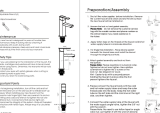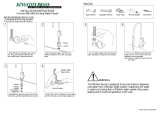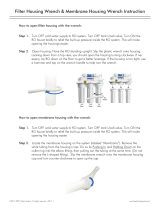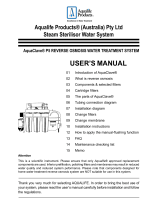

2
boannstyle.com
Installation Instructions Prelude
The Boann Reverse Osmosis 5-Stage Water Filtration System has been designed as a Do-It-
Yourself ltration system. However, it is recommended to acquire the services of a licensed
professional to facilitate and expedite the installation process. To ensure a successful
installation, as well a fully-operating ltration system, carefully read this manual and follow all
operational guidelines.
The installation instructions set forth in this manual are very detailed and thorough. Should you
experience a leak during installation or usage, please see the Leak Prevention section on
page 18.
ATTENTION: It is very important to change the lter of your system in order to ensure pure water
is being produced and to avoid any premature system degradation. After installation is complete
and deemed successful, please read the Recommended Filter Replacment Schedule section on
Page 19 and keep record on your calender when your system lters require replacement.
Reverse Osmosis 5-Stage Water Filtration System Specications
Dimensions:
R.O. System: 10.13” W x 14.63” H x 8” D
Tank: 11” W x 15” H x 11” D
Unit Weight: 11.5 lbs (R.O. System); 8 lbs (Tank)
Tank: 5 Gallons (Tank Capacity 3.2 Gallons)
Water Source Conditions:
Maximum Total Dissolved Solids (TDS): <2000 ppm
Water Pressure Range: 40-100 psi (2.8 bar)
Minimum Inlet Water Pressure: 40 psi (2.8 bar)
Water Temperature Range: 40 - 85˚F (4.5˚ - 30˚C)
Water pH Range: 4 -11
Pre-Installation Instructions

3
boannstyle.com
Table of Content
Installation Instructions for Reverse Osmosis 5-Stage Water Filtration System
Pre-Installation Instructions ........................................................................................................ 2
Installation Instructions Prelude ...........................................................................................................2
Reverse Osmosis 5-Stage Water Filtration System Specications ................................................2
Package Contents .......................................................................................................................... 4
Take Everything Outside of the Box ......................................................................................................4
Product Overview .......................................................................................................................... 5
Boann Reverse Osmosis 5-Stage Water Filtration System ..............................................................5
System Operation Filtration Chart ............................................................................................... 6
Tools to Complete Installation ............................................................................................................... 6
Installation Preparation ................................................................................................................ 7
Prepare Space for the Filtration System ............................................................................................... 7
Preparing the Feed Water to the System
....................................................................................8
Installing the Feed Water Connector
...........................................................................................8
Connecting the Feed Water Line to the Filtration System
......................................................... 10
The Auto Leak Detector Advantage
..........................................................................................11
Re-Activating the Auto Leak Detector
.......................................................................................11
R.O. Filtration System Installation ..............................................................................................12
Preparing the Discharge Water Drain Clamp ............................................................................ 12
Prepare the R.O. Pressure Storage Water Tank
........................................................................14
Installation of Standard Push-In Faucet
....................................................................................15
Installation of Standard Faucet
.................................................................................................16
Initiating the Water Filtration System
........................................................................................17
R.O. Filtration System Evaluation/Leak Prevention .................................................................18
Testing the Water Filtration System
..........................................................................................18
Threaded Fittings
....................................................................................................................... 18
Water Filtration Filter Schedule .................................................................................................19
Recommended Filter Replacement Schedule ...........................................................................19
Filter Replacement Guide ............................................................................................................20
Quick Twist Visual Guide - Filter Replacement...........................................................................20
Filter Replacement Instructions .................................................................................................21
Pre-Filters - How to Perform a Filter Replacement .................................................................... 21
Boann Manufacturer Warranty ..................................................................................................22
Table of Contents

4
boannstyle.com
Take Everything Outside of the Box
Examine the contents inside the box and make sure you have all required parts and accessories
to complete the installation process.
Parts Diagram 1
Parts Diagram 2
Parts Diagram 3
Package Contents
Drain Clamp ACW-2 Water Feed Connector
AB-3-4
Auto
Leak Detector
5 Gal. Pressure Storage
Water Tank
Faucet Adapter
LS-FA04-716
Needle Valve
NSV-1 (Optional
1.5m PE Tubes
(4 Tubes)
1/4” Manual
Shut O Valve
AVB-2-2B
D103 NSF Faucet
D103 NSF Faucet
Parts
Tank Ball Valve
LS-CV1144
Elbow
Connector - 4 x

5
boannstyle.com
Boann Reverse Osmosis 5-Stage Water Filtration System
FOR VISUAL REFERENCE PURPOSE ONLY: Provided below are images showing the front and
rear of the ltration system, with lters intact. We recommend to thoroughly read the installation
instructions step by step in order to expeditiously and correctly complete the installation process.
System Front View:
System Back View:
Product Overview

6
boannstyle.com
Tools to Complete Installation
System Operation Filtration Chart
Stage 1:
Sediment
Pre-Filter
Particle Removal:
Sand, Silt, Dirt,
Rust particles
Water
Source
Purified
Water
How Does RO System work?
Stage 2:
Granulated
Activated
Carbon Pre-Filter
Microfiltration:
Chlorine, Odor,
Organic Chemicals
Stage 3:
Carbon
Pre-Filter
Ultrafiltration:
Chlorine,
Bad taste, Odo
Stage 4:
RO Membrane
Filter
Reduce 98% of
dissolved minerals,
salts and most
harmful chemicals
Stage 5:
Post Carbon
Filter
Improves water
purity by
reducing chlorine
& odor
Bacteria
Viruses
Pesticides
Estrogen
Synthetic Dye
Viruses
Asbestos
Bacteria
Pesticides
Pesticides
Pesticides
Reverse Osmosis Element
0.0001 Micron pore size:
Water
Tank
Industrial-Grade Scissors Plumbing Gloves
Teon Tape
Wrench

7
boannstyle.com
Installation Preparation
Prepare Space for the Filtration System
Before installation is initiated, it is advisable to clean out space underneath the sink in which the
ltration system will be installed. Evaluate the area underneath the sink and determine the proper
location for the unit and tank. Please consider easy accessibility, as it is required to periodically
service the ltration system and its parts.
Tip!
Understanding installation will likely cause water to splash or drip from the ltration
system during installation and/or servicing, it is advisable to stand the unit inside a
drip pan. Disposable aluminum baking sheets sufce for this application.
Picture of completed system assembly

8
boannstyle.com
Preparing the Feed Water to the System
Underneath the sink are located the water supply shut off valves to the Hot and Cold water lines.
Before installation commences, please SHUT OFF the main water supply line and the Hot and
Cold water valves. After, turn on the sink cold water tap to make sure there is no water
owing from the sink faucet. At this point there should be no water owing.
WARNING! Do not attach the system to the Hot water line as hot water will damage the lters
with the system.
Installing the Feed Water Connector
1. After turning off the cold water valve, the detachment of the cold water hose will be required.
With use of a wrench, carefully unscrew the water hose from the cold water valve.
Installation Preparation
Turn Off Cold Water Valve
(Turn Clockwise)
Note!
Please understand even though the instructions contained herein use the
Manual Shut Off Valve to complete installation, the provided supplement Needle
Valve NSV-1 can be used instead of the Manual Shut Off Valve to complete
installation. The installation process is the same.

9
boannstyle.com
Installing the Feed Water Connector
2. After the cold water hose is detached, use the wrench to unscrew the cold water valve from
the cold feed water pipe.
3. Thoroughly attach the Manual Shut Off Valve to the Water Feed Connector with wrench.
Tighten the Water Feed Connector to the cold feed water pipe, followed by the connection of
the cold water valve onto the Feed Water Connector.
3. Reattach the cold water hose onto the cold water valve. Locate the red PE tubing and slide the
threaded nut onto one end of the red PE tubing and attach the tubing onto the Manual Shut Off
Valve. Screw the nut onto the Manual Shut Off Valve.
Installation Preparation
Turn Off Cold Water
Valve (Turn Clockwise)

10
boannstyle.com
Connecting the Feed Water Line to the Filtration System
Depending on the proximity and distance of the ltration system to both the Auto Leak Detector
and cold water valve, measure the distance between each component and carefully cut the red
PE tubing in half. Take one piece and rmly insert one end into the Inlet port located on the rear of
the system. Attach the other end to the R.O. System Out port on the Auto Leak Detector. Next, use
the other red PE tubing and attach it to the Main Line-In port on the Auto Leak Detector. The other
end of the tubing is already attached to the Manual Shut Off Valve (per previous step).
Inlet Port Manual Shut Off Valve
Auto Leak Detector
IMPORTANT: The Auto Leak Detector comes with an adhesive footing to adhere and hold the
module in a desired location. However, two screws are provided to assist with securing the unit
into place. Insert the two screws into the two side brackets and drill into the surface.
Installation Preparation
To R.O. System - Out
Side Bracket for Screws
From Main
Line - In
(Feed Water)
Note!
Although the Leak Detector is a invaluable safeguard against leakage, it is
considered an optional part and therefore is not required for full system operation.
Therefore, connecting the red PE tubing from the Manual Shut Off Valve to the Inlet
input port on the system will complete water main line system connection.

11
boannstyle.com
The Auto Leak Detector Advantage
The Boann Reverse Osmosis 5-Stage Water Filtration System comes exclusively with an Auto
Leak Detector module, which is an invaluable part of the system and serves to detect the
presence of water (leakage) around the system. Should the Auto Leak Detector sense the
presence of a leakage, a water-absorbent cell will absorb neighboring water and initiate a
system shut-down, thus stopping excess water from damaging the unit and the
surrounding environment.
Leak Detector Parts:
Re-Activating the Auto Leak Detector
1. Every Auto Leak Detector module comes with 2 internal water-absorbent cells. Should the
system initiate a shut-down due to a leak, the replacement of the used cell will be required.
2. To open the housing module, simply pry the upper - spring trigger with your hand or use a at
screwdriver to detach (pry) the upper from the housing.
3. Next, detach the blue cell holder and discard the used cell. Place a new cell inside the cell
holder and reinsert the upper - spring trigger onto the lower housing, making sure the spring
inserts into the cavity of the cell holder.
4. Apply rm pressure to connect the upper to the lower housing. You will hear a click when the
module is correctly assembled.
5. Reinstall or house the Auto Leak Detector back in its original location.
NOTE: Replacement water-absorbent cells can be purchased separately
Installation Preparation
Manual Shut Off Valve
Cotton Water-Absorbent Cell
Leak Detector Housing
Used - Cotton
Water-Absorbent Cell
Upper - Spring
Trigger

12
boannstyle.com
Preparing the Discharge Water Drain Clamp
Find the location on the drain pipe under your sink where you wish to secure the Discharge
Water Drain Clamp. CAUTION: Make sure the location chosen is above the Trap. (The Trap is the
“U” shape part of the drain pipe) You may secure the saddle clamp on the horizontal pipe, as long
as the clamp is above the Trap. It is also advisable to secure the drain clamp in a location that it is
not blocking anything.
1. Drill out the chosen spot with a 1/4” drill bit. The 1/4” hole that is created into the chosen
location on the drain pipe is where the black discharge line will be inserted and secured
into place with the Discharge Water Drain Clamp.
2. Now take the rubber gasket that accompanied the Discharge Water Drain Clamp and remove
its paper backing.
R.O. Filtration System Installation
Turn Off Cold Water
Valve (Turn Clockwise)
Rubber Gasket
Drain Trap
Tip!
The material of the Discharge Water Drain Clamp is exible. If your drain is larger
than the circumference of the drain clamp, press the clamp rmly onto the drain in
order to catch the bolts on the opposite side. It is required only to tighten the bolts
where the gasket begins to compress against the drain pipe.

13
boannstyle.com
3. Adhere the gasket to the interior of the Discharge Water Drain Clamp. Now stick the black PE
tubing into the drain clamp, making sure the tubing is protruding through at least 1/2 inch.
4. Now rmly secure the Discharge Water Drain Clamp in its chosen location, making sure the
tubing is inserted into the drain pipe by 1/4 inch (as shown).
5. Assemble the two pieces of the Discharge Water Drain Clamp with use of the two screws and
bolts. Now attach the black PE tubing discharge line into the Drain input port on the rear of the
R.O. ltration system.
Assembled Discharge Drain Clamp Drain Input Port
R.O. Filtration System Installation

14
boannstyle.com
Prepare the R.O. Pressure Storage Water Tank
The R.O. Pressure Storage Water Tank has both an air and water bladder built inside it. The air
bladder comes pre-set from the factory at 7 PSI. NOTE: Changes to the PSI of the air bladder
inside the water tank may cause harmful back pressure which can result in damage to
the R.O. ltration system.
Connecting the R.O. Pressure Storage Water Tank
1. Screw the Tank Ball Valve onto the threads located on top of the water tank. For security, apply
5-8 wraps of Teon tape to the thread of the tank.
2. The yellow PE tubing will now be used to connect the system to the R.O. Pressure Storage
Water Tank. Connect the yellow PE tubing into the Tank Ball Valve atop of the water tank and
connect the other end to the Tank input port on the R.O. Filtration System.
Tank Input Port Ports with Elbow Connectors
R.O. Filtration System Installation
Tank Ball Valve
Tip!
The Boann Reverse Osmosis 5-Stage Filtration System comes with 4 elbow
connectors (shown above) which can be used for convenience and facilitate for
diverse placement of the system. The elbow connectors help point tubing in
diverse, desired directions.

15
boannstyle.com
Installation of Push-In Standard Faucet
At this point the blue PE tubing will be used to connect the R.O. ltration system to the faucet.
The length of tubing used to hook up the kitchen faucet should be long enough to connect to the
Faucet input port. Take a moment to assess and measure the amount of tubing required for the
application. Once an accurate measurement is taken, cut the blue PE tubing with scissors or a
sharp knife. Make certain the cut is straight and not at an angle.
Now insert one end of the customized blue PE tubing into the Faucet input port on the rear of the
ltration system. The other end will connect to the faucet adapter.
Installation Steps
1. Drill a 1/2” hole in the sink or
counter top, or utilize an existing
hole (should it be the
appropriate size).
2. Slide chrome cover plate and
rubber gasket onto stem of
faucet and place the faucet
onto the sink, with the stem
going through the hole.
3. Place the rubber washer and
metal tooth washer over
threaded stem of faucet.
4. Tighten the faucet nut from
under the counter surface to
lock the faucet into place.
5. Thread the faucet adapter
onto the faucet’s threaded stem.
Do not use Teon tape.
6. Firmly push the blue 1/4” tubing into the faucet adapter.
Check over all of the steps. Make sure all of your tubing is inserted rmly into the
respective inputs!
R.O. Filtration System Installation
Counter Top
Chrome Cover Plate
Rubber Gasket
Rubber Washer
Metal Tooth Washer
Faucet Nut
Faucet Adapter 1/4” x 7/16”
Blue 1/4” Tubing

16
boannstyle.com
Installation of Standard Faucet
At this point the blue PE tubing will be used to connect the R.O. System to the faucet. The length
of tubing used to hook up the kitchen faucet should be long enough to connect to the Faucet input
port. Take a moment to assess and measure the amount of tubing required for the application.
Once an accurate measurement is taken, cut the blue PE tubing with scissors or a sharp knife.
Make certain the cut is straight and not at an angle.
Now insert one end of the customized blue PE tubing into the Faucet input port on the rear of the
ltration system. The other end will connect to the faucet assembly.
Installation Steps
1. Drill a 1/2” hole in the sink or
counter top, or utilize an
existing hole (should it be the
appropriate size).
2. Slide chrome cover plate and
rubber gasket onto stem of
faucet and place the faucet
onto the sink, with the stem
going through the hole.
3. Place the rubber washer and
metal tooth washer over
threaded stem of faucet.
4. Tighten the faucet nut from
under the counter surface to
lock the faucet into place.
5. Slide the compression nut and
ferrule onto the blue tubing.
6. Insert the tube inset into the
opening end of the blue tubing.
6. Thread the compression nut
onto the faucet’s threaded stem, securing the blue tubing.
Check over all of the steps. Make sure all of your tubing is inserted rmly into the
respective inputs!
R.O. Filtration System Installation
Counter Top
Chrome Cover Plate
Rubber Gasket
Rubber Washer
Metal Tooth Washer
Faucet Nut
1/4” Compression Nut
Blue 1/4” Tubing
1/4” Tube Inset
1/4” Ferrule

17
boannstyle.com
Initiating the Water Filtration System
Opening All Water & System Valves
At this point in time, you can now turn on the home water main supply line back to its ON position.
Proceed to turn ON both the Hot and Cold water valves and all ltration system valves, including
the Manual Shut Off Valve and Tank Ball Valve on top of the R.O. Pressure Storage Water Tank.
Flushing the Reverse Osmosis 5-Stage Filtration System
PLEASE NOTE: By turning the cold water shut off valve ON, water is effectively owing through
the system, thereby ushing the system of any and all loose particulates and carbon dust.
IMPORTANT: It is advisable to turn on the cold water tap on the kitchen faucet to make sure there
are no leaks anywhere in the plumbing system.
It is important to allow the water to run through the system for one (1) hour to initiate the Reverse
Osmosis process and ensure proper system ushing. In that the R.O. Membrane is lled with food
preservative for quality assurance, it is advisable to ush it out with water, along with the Post
Carbon Filter and the Water Storage Tank’s bladder before water consumption.
R.O. Filtration System Installation
OpenClose
Close Open

18
boannstyle.com
Testing the Water Filtration System
After letting the system operate for one (1) hour, turn on the ltration systems faucet and let the
water run for about 1-2 minutes. Invariably you will evaluate dark, murky water coming from the
faucet. This is normal and reects loose particulates and carbon dust being ushed out from the
system. After approximately 2 minutes clean water will be visible, indicating the system is fully
operational and thus producing clean, drinkable water.
This concludes the installation process and you may now start drinking puried water from the
Boann Reverse Osmosis 5-Stage Water Filtration System. Enjoy!
If you require further information and/or clarication regarding the installation process, please
feel free to contact Boann at: [email protected].
Threaded Fittings
To prevent a leak on any threaded tting that screws into the
Reverse Osmosis 5-Stage Water Filtration System, please
employ Teon tape by way of wrapping the threads of the
various threaded ttings 5-7 times.
This preventative measure will assist in preventing potential
leaks from the threaded ttings throughout the R.O. ltration
system.
If there are signs of leakage from a 1/4” tube
inserted into a threaded tting, simply push and insert the
threaded tting further. To facilitate this process, use pliers
and grab the tubing 1/2” from where the tube inserts into the threaded tting. This will help avoid
damaging the tubing which will be inserted into the threaded tting and invariably prevent
leakage from this location.
R.O. Filtration System Evaluation/Leak Prevention
Tip!
Maintaining the pre-lters of your system is key to ensure the ltration system
sustains integrity in both water quality production and longevity of its parts and
components. The pre-lters are the ltration systems rst line of defense and thus
paramount in promoting the maximum lifespan of the R.O. Membrane.

19
boannstyle.com
Recommended Filter Replacement Schedule
Pre and Post Filters: Dened as the lter stages Pre (before the R.O. Membrane) and Post (after
the R.O. Membrane).
Stage 1, 2 & 3 Pre-Filters - When to Conduct a Filter Change.
Stages 1, 2 & 3 are the ltration system’s pre-lters which need to be changed approximately
every 1,000 gallons or every 6-months. On average households consume about 5 gallons of
drinking and cooking water daily and, as such, a lter change is required every 6 months or
sooner. For your convenience, a monthly maintenance schedule checklist is provided on the
label of each lter to keep record of routine lter maintenance. As an added measure, mark your
calender for a routine lter change every 6 months.
WARNING! If the pre-lters are not changed before 1,000 gallons of puried water is produced,
chlorine will bypass the pre-lters, thus entering and damaging the R.O. Membrane, rendering it
useless and in need of premature replacement.
Stage 4 - Reverse Osmosis Membrane Replacement
The R.O. Membrane is the most important component of the Boann Reverse Osmosis 5-Stage
Water Filtration System. The R.O. Membrane is rated for 4,000-5,000 Gallons of puried water
production. A new R.O. Membrane will last approximately 3-4 years. However, it is suggested
replacing the R.O. Membrane every 2 years for system and performance optimization.
• A standard household will consume between 3-5 gallons of puried water each day for
drinking and cooking. A 3-gallon per day consumption rate over a year’s time is equal to
roughly 1095 gallons, which therefore requires the Reverse Osmosis Membrane to be
changed about every 3.5 years.
• A 5-gallons per day consumption rate over a year is equal to approximately 1825
gallons which in turn requires the Reverse Osmosis Membrane to be changed
about every 2-2.8 years.
When in Doubt, Replace the R.O. Membrane
Boann recommends to replace the R.O. Membrane if it has never been replaced and if the
R.O. ltration system is more than 3 years old. If the age of the R.O. Membrane is unknown, it is
recommended to replace the lter as soon as possible.
Stage 5 - Post Carbon Filter Replacement
The Post Carbon Filter is the last ltration stage in the Boann Reverse Osmosis 5-Stage Water
Filtration System. The Post Carbon Filter is rated for 1800-2000 gallons of puried water
production and should be changed once a year or every second time you change the three
pre-lters.
Water Filtration Filter Schedule

20
boannstyle.com
Quick Twist Visual Guide - Filter Replacement
Filter Replacement Guide
Step 1
Lift up lter approximately
30-degrees from
R.O. ltration system.
Step 2
Twist lter counter-clock-
wise and gently remove
the lter from the
lter housing.
Step 3
Twist on replacement lter
and position back
into place.
Page is loading ...
Page is loading ...
-
 1
1
-
 2
2
-
 3
3
-
 4
4
-
 5
5
-
 6
6
-
 7
7
-
 8
8
-
 9
9
-
 10
10
-
 11
11
-
 12
12
-
 13
13
-
 14
14
-
 15
15
-
 16
16
-
 17
17
-
 18
18
-
 19
19
-
 20
20
-
 21
21
-
 22
22
Ask a question and I''ll find the answer in the document
Finding information in a document is now easier with AI
Related papers
Other documents
-
ISPRING FT15 User manual
-
ISPRING L8114BN User manual
-
Global Water WATERBOXNANO User manual
-
 Boyel Living RB0707 Installation guide
Boyel Living RB0707 Installation guide
-
Novatto TCV-005AN Installation guide
-
 Kingston Brass HKS7195CFL Installation guide
Kingston Brass HKS7195CFL Installation guide
-
 APEC Water Systems WRENCH-HALF User manual
APEC Water Systems WRENCH-HALF User manual
-
 AquaLife AquaClave P5 User manual
AquaLife AquaClave P5 User manual
-
No Brand RO300, 110-120 V User manual
-
Electrolux WE 2000 E User manual
































